Table of contents
- Restoration Sauerborn-Munch TTS 1200 Turbo The long way
- That’s over with romance
- New stainless steel elbow from the specialist
- “Four people, one of whom was supposed to be a gynecologist”
- About Arno Sauerborn
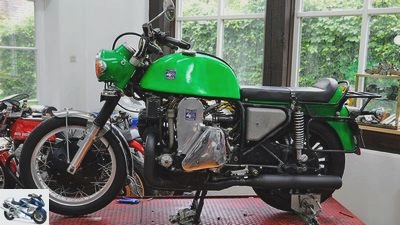
Siemer
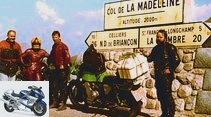
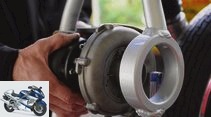
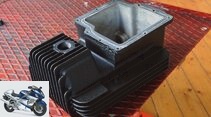
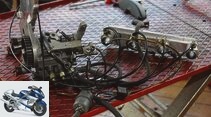
24 pictures
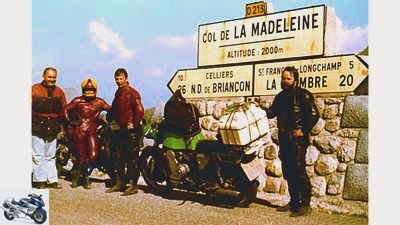
Siemer
1/24
The Munch was owned by Arno Sauerborn for 44 years. In doing so, it often had to serve as a motorhome: in the very first summer it fell flat on the way to the Alps.
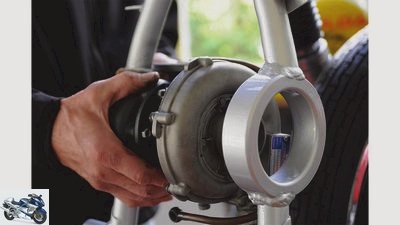
Siemer
2/24
So that the turbocharger could find its intended place, Arno Sauerborn simply cut the Munch frame and welded two circular segments into place. …
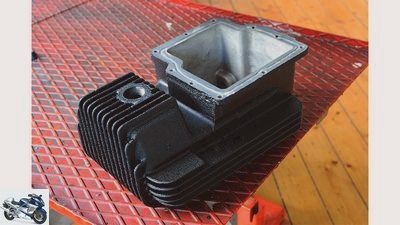
Siemer
3/24
It is important that special Munch parts such as the oil pan are intact.
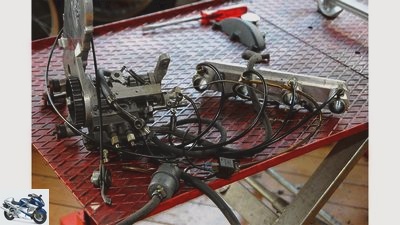
Siemer
4/24
The injection system comes from the BMW 2002 ti and was adapted to the Turbo-Munch with own funds.
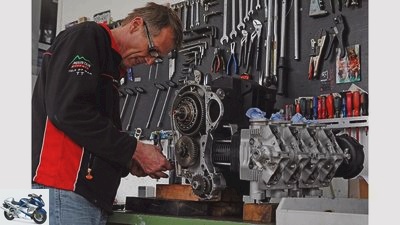
Siemer
5/24
The many seals in a Munch engine require special care.
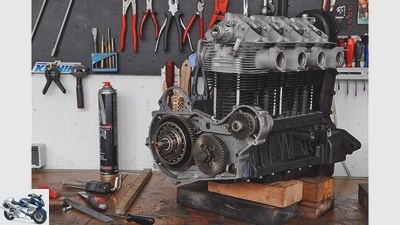
Siemer
6/24
The turbo-Stegemann-Sauerborn-Munch engine has a displacement of 1188 cm³ and achieves an output of around 110 hp at 6000 rpm.
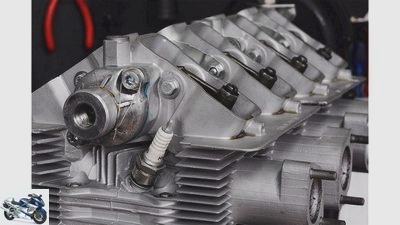
Siemer
7/24
The four-cylinder, four-stroke in-line engine has an overhead camshaft.
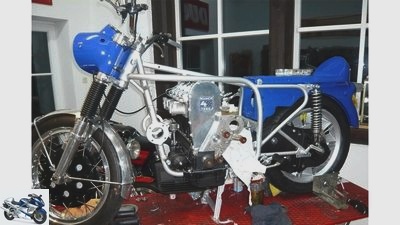
Siemer
8/24
After the frame and engine have each been restored, assembly can begin.
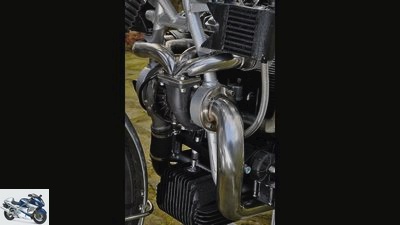
Siemer
9/24
The turbocharger.
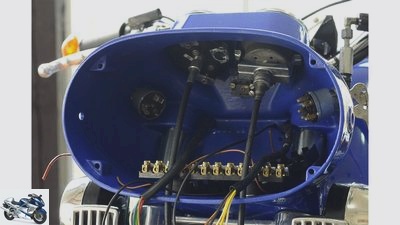
Siemer
10/24
The connector strips in the pot of the distinctive double headlight look more rustic, but that’s exactly how Friedel Munch wanted it.
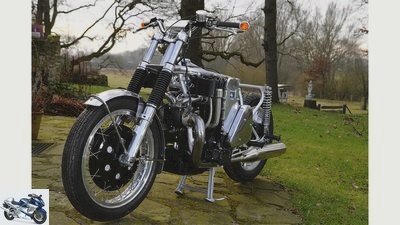
Siemer
11/24
Not even complete, but already a radiant appearance. Turbo-Munch cost around 500 working hours.
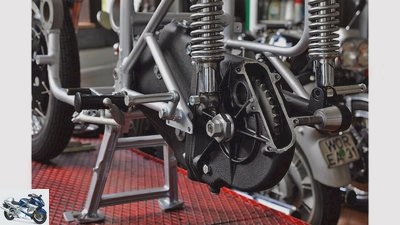
Siemer
12/24
Sauerborn-Munch TTS 1200 Turbo.
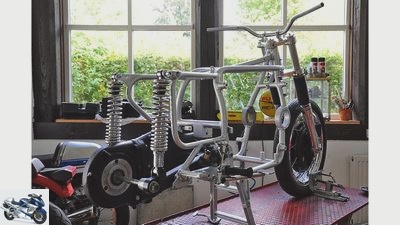
Siemer
13/24
… That works fine, but makes installing and removing the engine a puzzle game.
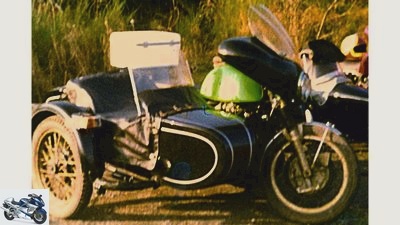
Siemer
14/24
But also otherwise the Munch had to work hard, they dragged a sidecar for many kilometers. The idea probably came up …
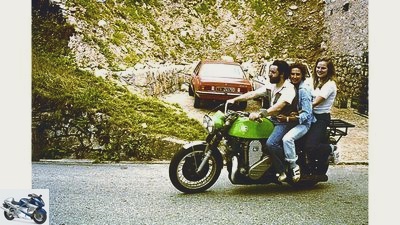
Siemer
15/24
… at this very moment.
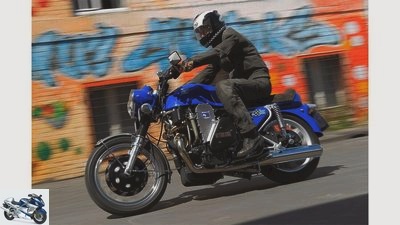
Siemer
16/24
And that’s the same bike today, restored and now in second hand.
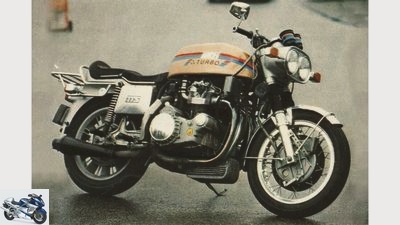
Siemer
17/24
Incidentally, Sauerborn had the idea for his conversion himself, he did not know the Stutz-Munch.
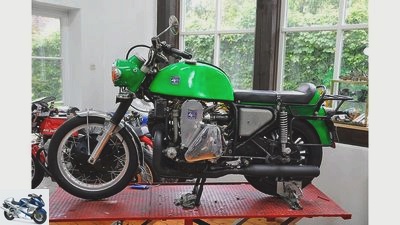
Siemer
18/24
Number 128 on the operating table.
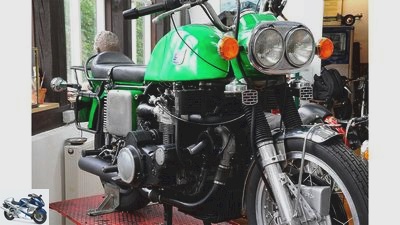
Siemer
19/24
Martin Stegemann has already restored many Munch, …
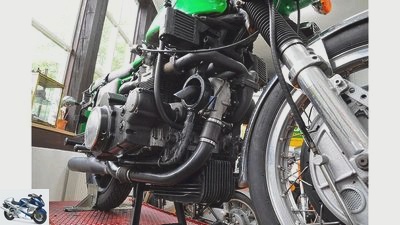
Siemer
20/24
… So now there was a Munch Turbo. And this first-hand copy was simply irresistible for Stegemann.
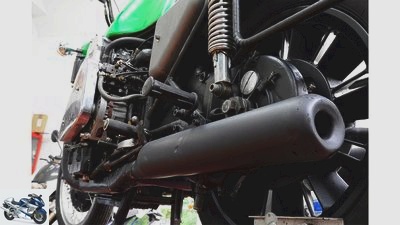
Siemer
21/24
The ailing exhaust system was coated with ceramic.
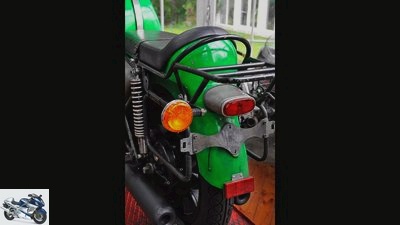
Siemer
22/24
Sauerborn-Munch TTS 1200 Turbo.
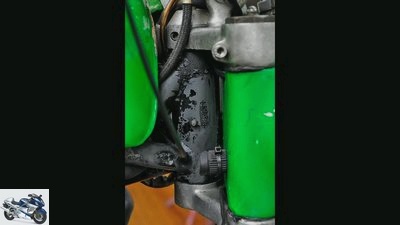
Siemer
23/24
That “Name tag” the Sauerborn-Munch TTS 1200 Turbo: number 128.
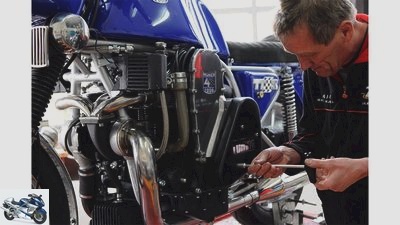
Siemer
24/24
Restorer Martin Stegemann during the final inspection.
counselor
workshop
Restoration Sauerborn-Munch TTS 1200 Turbo
Restoration Sauerborn-Munch TTS 1200 Turbo
The long way
Content of
Anyone who has already restored several Munchs has to dare to try a turbo. The lover Martin Stegemann found this one in particular irresistible.
Fred Siemer
03/18/2016
Of course, everyone is Munch something special. But among the almost 500 four-cylinder engines from the Hessian genius Friedel there are some very special ones. The only Turbo-Munch in the early, so sidecar-compatible frame, for example. Together with the burned down conversion of the Siegfried Stutz, this machine built by Arno Sauerborn can be considered a source of inspiration for the few turbo mammoths made by Friedel Munch himself. And the well-networked specialist Martin Stegemann got wind of this one-off around three years ago. The attraction: “That someone equips a Munch with a loader in a completely unconventional way and the whole thing works for decades in the end.”
Buy complete article
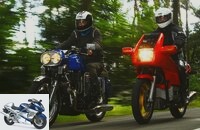
On the move with Sauerborn-Munch TTS 1200 Turbo and support BMW K 100 RS Turbo
Turbo classic
14 pages) as PDF
€ 2.00
Buy now
The sales negotiations were done quickly, and this visibly used and oily, unfit to drive monster was already standing in the workshop. There it met all expectations: a gear wheel had broken, the pistons were outside the specified dimensions in every respect, most of the seals had more or less stopped working. Odds and ends. Much more important when restoring a Munch are the brand-specific parts. Oil pan, primary drive and gearbox housing, rear wheel, swing arm including chain case, brakes and wheel hubs, lamp housing, tank and bench base, all of which confirmed the usable condition that the visual inspection before the purchase had indicated. “Fortunately,” says Stegemann, “because a new gearbox alone drives the price of a Munch restoration up to around 10,000 euros.”
That’s over with romance
In contrast to other projects, the goal of this restoration was clear from the start. Stegemann didn’t want a “Friedel-Munch”, but an “Arno-Munch”. As far as possible all technical ideas of the first owner and turbo upgrader Sauerborn should be kept. The master precision mechanic prefers to get the required engine parts from NSU specialists. In the present case everything was in stock. Pistons, valves and guides, all bearings. The due gear wheel and special Munch seals were supplied by the experts from DBH-Motorradtechnik in Luneburg. Stegemann retained the improvements made by Sauerborn, such as roller bearings instead of ball bearings for the gear wheels and spherical roller bearings at the gear output. “Can’t hurt, the four-speed gearbox is not exactly considered the strongest side of a Munch.” Of course, because of the additional turbo boost, the secondary drive and fourth gear with a “longer” ratio remained.
The reconstruction of the engine and gearbox went smoothly, as with every Munch, the pitfalls arise when it is to be turned into an engine. In the Hessian manufactory, only small series were produced, each a little different, and something built here and there by each one. No two Munch are alike, this saying loses its romantic overtones for the restorer, and anyone who does not develop technical ambition will never get such a thing dry. Martin Stegemann also needed two attempts when joining the primary drive housing, engine block and gearbox in order to adequately supply the unbelievably large number of sealing surfaces by means of precisely applied sealing compound. For the clutch, he relied on Sauerborn’s self-designed and built hydraulic actuation, and he also reinstalled the reinforced clutch springs.
New stainless steel elbow from the specialist
However, the exhaust system built by its predecessor and now heavily damaged was less popular. Their early industrial charm bounced off the avowed esthete Stegemann, so something new was needed. With slightly different bends directly at the turbo inlet, a specialist created a new stainless steel elbow, also the almost arm-thick pipe to the distributor. From there, the exhaust gases flow into two new stainless steel end pots, identical to those from Munch. While the exhaust tract easily tolerated a certain will to design, the opposite side needed humility: in the case of the mechanical injection system, the punches were ejected and made usable again, but that was it. “I had to rely on her working reasonably well,” admits Stegemann.
The problem? With the mechanical injection of the company “FAG Kugelfischer Karl Schafer”, which has been used in many automobiles since the early 1960s and also in the Munch TTS-E since 1973, only the stroke of the delivery piston (plunger) measures the amount of fuel injected . Each cylinder has its own stamp, these sit on a swing arm mounted on one side. And on the other side of the swing arm bearing is the so-called space cam. This rotatable, conical part has many sensibly attached elevations and depressions, with increasing speed it changes its position as well as with changed throttle valve opening – and thus also the punch stroke. A mechanically mapped map, if you will. The mechanics call the little miracle cone potato, which has to be specially shaped for each engine. In fact. For a lot of money. Friedel Munch once calculated 35,000 marks with his thumb and, because he did not want to raise this sum, applied an overpressure membrane to the charger on his own turbo motorcycles, which activates the choke system.
“Four people, one of whom was supposed to be a gynecologist”
Arno Sauerborn, on the other hand, first worked a little on the potato intended for the two-liter BMW 2002 ti and, secondly, provided a mixture enrichment using the handlebar. It also worked, he says, and Martin Stegemann had to believe him. Before he could check the statements while driving, there was unfortunately a forced break, because the painter had forgotten that many Munch parts are made of electrons, i.e. highly alloyed magnesium. That is why they have to be repainted immediately after processing to avoid oxidizing. Otherwise the paint will puff up. There are things.
When it was completed, the Japanese fittings that had smuggled onto the handlebars in the pragmatic Sauerborn era were replaced. “That is not in keeping with the style,” says Martin Stegemann, “there are now BMW parts.” The earliest Turbo-Munch still in motion cost him almost a year of project and probably around 500 hours of working time. A unique specimen in this scene and in the German motorcycle landscape. “The most difficult thing,” the experienced precision mechanic sums up, “was getting the engine into the frame. You need four people for that, one of whom should be a gynecologist. ”And why? Because of the welded-in circle segments. That’s just how it is with an Arno-Munch.
About Arno Sauerborn
Arno Sauerborn is – with all due respect for Friedel’s achievements – not a Munch disciple, but has simply been an absolute motorcycle fan for decades. As early as 1964, the trained car mechanic owned a Honda C 72, then a CB 450, then a Kawasaki 500 H1, and drove, drove, drove. At the end of the 60s, of course, the Munch was an issue, at the end of 1970 it was in the courtyard. A TTS 1200. He then owned it for 44 years, but often also other motorcycles on the side. Big ones, suitable for traveling, the woman always came with me.
Today Sauerborn drives a Yamaha FJR 1300. The Munch also often had to serve as a motorhome, and in the very first summer it gave up on the way to the Alps. Shift claw broken. Sauerborn let himself be dragged from Kitzbuhel to Altenstadt to Friedel Munch by his fellow CB 750 companion, and he repaired the transmission on Sunday morning. Back then, buddies were not only reliable, they also made people think: Why did they always drive the supposedly most powerful production motorcycle in the world in front of their noses? A turbocharger promised a remedy, which came in 1976 and Sauerborn got his nickname. The Rhinelander Sauerborn still sees the matter of the severed frame full of humor today: Nobody ever asked about it. It was also trustworthy, and it lasted a few years with a trailer, all the way up to Norway for the Krystall rally. The clutch springs were already reinforced. In 1980, the injection system came on board to get rid of the tricky carburetors and reduce fuel consumption. Around 200,000 kilometers have come together. And then it was good to give it up, the coin of life.
Related articles
-
fact motorcycles Final: Munch-4TTS-E 1200 Final: Munch-4TTS-E 1200 Friedel’s original creature It wasn’t Soichiro Honda who built the first…
-
www.r-photography.info 9 pictures www.r-photography.info 1/9 BMW K 1200 GT. BMW 2/9 Large fairing, but quite narrow for a touring bike; Case and…
-
Ducati Multistrada 1200 S in the driving report
Photo: Ducati 34 pictures Ducati 1/34 Ducati Multistrada 1200 S.. Ducati 2/34 Ducati Multistrada 1200 S.. Ducati 3/34 Ducati Multistrada 1200 S.. Ducati…
-
Exclusive driving report BMW K 1200 S
fact motorcycles Tourer Exclusive driving report BMW K 1200 S Exclusive driving report BMW K 1200 S Dare to do sport BMW relies on sport. But not just…
-
Harley-Davidson XL 1200 Sportster for sale
Harley-Davidson 13th pictures manufacturer 1/13 manufacturer 2/13 Gargolov 3/13 Gargolov 4/13 jkuenstle.de 5/13 jkuenstle.de 6/13 manufacturer 7/13 ……
-
Stefan Kraft 7th pictures Stefan Kraft 1/7 2020? Honda CX 1200 compressor Ain’t she pretty MOTORRAD in-house designer Stefan Kraft transports the old CX…
-
Honda CBR 1100 XX, Kawasaki ZZR 1200, Suzuki Hayabusa 1300 and Yamaha FJR 1300
MOTORCYCLE archive counselor Used purchase Honda CBR 1100 XX, Kawasaki ZZR 1200, Suzuki Hayabusa 1300 and Yamaha FJR 1300 Honda CBR 1100 XX, Kawasaki ZZR…
-
Triumph Speed Triple 1200 RS: Almost everything new
News 2022 New motorcycle items for 2022 Triumph Motorcycles 44 pictures Triumph Motorcycles 1/44 The new Speedy 1200 RS has new headlights that are very…
-
Suzuki patent for 650 cc parallel twin with turbo
Suzuki 19th pictures Suzuki 1/19 This is what the XE7 engine looked like as a 2013 and 2015 design study. The basic architecture of the turbo system has…
-
Driving report Kawasaki ZRX 1200 S and ZR-7 S
motorcycles Driving report Kawasaki ZRX 1200 S and ZR-7 S Driving report Kawasaki ZRX 1200 S and ZR-7 S Partly cheerful With the ZRX 1200 S, Kawasaki is…